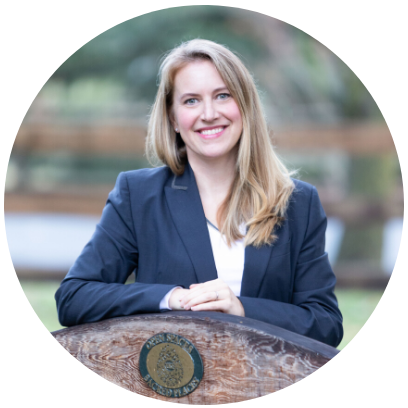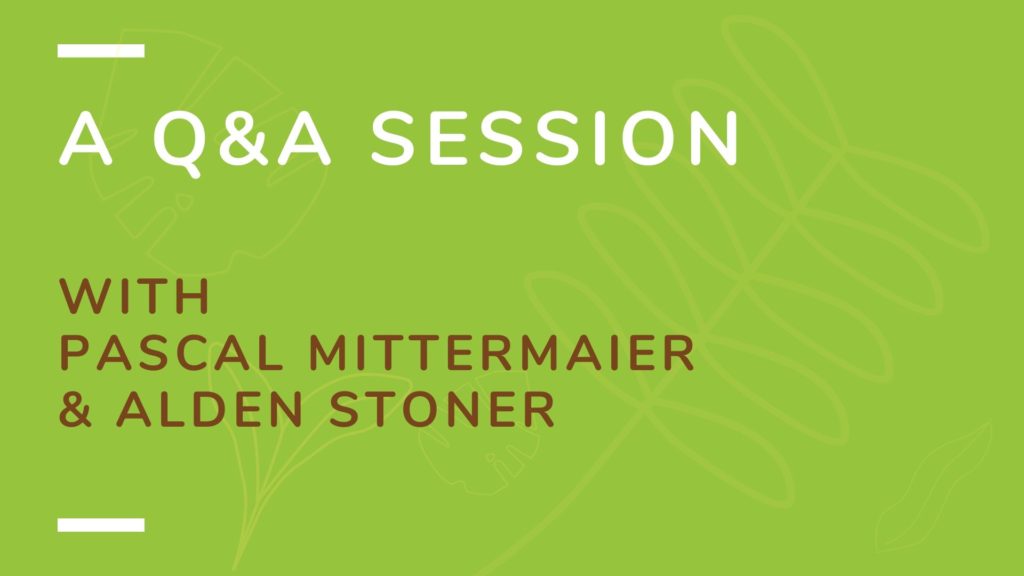Spend five minutes with Alden Stoner, Nature Sacred’s new CEO, and you’ll be struck by a couple of things immediately. One, she is perfectly certain that nature can help cure many of the seemingly most intractable issues saddling Western society today — including the overwhelming stress being caused by the current COVID-19 pandemic; and two, she has a sense of urgency that is more commonplace in corporate America.
A lot can be shared in five minutes together. To that end, we wanted to create the experience of a five-minute meeting—as much as possible—right here.
We decided that the best way to do this would be via an old-school Q&A. We arranged for her to sit down (via video, due to social distancing safety measures) with Pascal Mittermaier, former Global

Managing Director, Cities, for The Nature Conservancy, and one of the newest additions to Nature Sacred’s Board, inviting her to riff on a range of topics. A little further below is a lightly-edited transcript of the conversation.
But first, a brief bit of background. An introduction of sorts to set things up. Though Alden has served on Nature Sacred’s board for nearly 15 years and is originally from the area, she only recently returned to Annapolis after having called the West Coast home for more than two decades. It was in Los Angeles that she spent many of what she describes as meaningful years of her career with an award-winning media production company that focuses on entertainment that inspires social change.
As a leader of the Social Impact department at Participant Media, she helped forge strategic partnerships and create compelling calls to action to urge personal, policy and systems change on a variety of issues like hunger, predatory prison phone calls, and mental health. (Hence her well-ingrained sense of urgency.)
Alden attributes her work at Participant for deepening her long-held desire to make movies “that matter”, and for inspiring her to create the Nature Sacred series of short-films. These included Butterfly Angels that was screened at the National League of Cities Conference and Heart of the Hospital, which launched at the annual SHIFT Festival.

With that footing, let’s dive into the Q + A:
P.M.: Why this change for Nature Sacred—and why now?
A.S.: We didn’t want to continue the organization just to continue it. In fact, we had planned to sunset the grant-giving version of Nature Sacred. In that wind-down process, we were unexpectedly gaining more and more momentum and requests for our expertise from across the country and even across the globe.
It seems we are at a moment — a critical tipping point for the future of the human race. The further we as humans get from nature, the sicker we both become. By bringing nature nearby, especially contemplative places that offer us the opportunity to separate ourselves from the stressors of daily life, we have the opportunity to connect with ourselves and our world to improve the health of both. Humans are now an endangered species. With the prevalence of loneliness, the opioid crisis, gun violence, and ramifications of the Coronavirus and more. Nature Sacred is working to address these human crises in a way that no one else is doing.
The years we have invested in truly immersing ourselves in the communities, in honing our model—in forging relationships with researchers. We feel Nature Sacred is uniquely positioned and experienced to bring a lot of positive change to the world. We believed that before the pandemic hit. And now, with this new layer of global anxiety and worry caused by the Coronavirus, we have an even deeper understanding of the importance of nearby nature communities across the globe.
P.M. Why you?
A.S.: You might say this work is in my blood. I was still in high school when Nature Sacred was established. After college, during my years on the board, my belief in this work continued to grow. The belief deepened when I met one particular Firesoul, Chris Cotten, from Joplin, Missouri. I met him during our national grant awards program and was so moved by what he did as a first responder and what he and his team did to clean up and revitalize the town in the wake of the terrible tornado tragedy, I wanted to make a film about him. But when I got back to LA my career at Participant Media supercharged and I couldn’t take on side projects, but I kept his name on my bulletin board and looked at it every day. Just after I left Participant, I was sitting on my couch and got a call from Chris. He said, “I don’t know if you remember me, but I was recently diagnosed with PTSD and my therapist said I need to tell my story, and you were the first person I thought of.” It was cosmic. Within 3 weeks, I had a team, and we met down in Joplin to make a short film about him and the Butterfly Garden and Overlook. This is what set off a chain of short films meeting the Firesouls, the end-users, the researchers on the front lines. This work MOVES people. Being in quiet contemplative nature strengthens individuals and communities. As one of our research partners, Keith Tidball says, “When you’re hurt, nature heals.” The full realization of the depth of need for this work compelled me to take on this role.
P.M. Why now?
A.S.: I’ve frequently worked at established organizations that are looking to scale. I love being at the phase of growth where you have a great product or service and it’s really about amplifying awareness – helping it catch fire. This is where Nature Sacred is now. We have the proof of concept and process with over 150 spaces, and the research to support the work. Now it’s about broader adoption. At this moment, I don’t believe there is any other organization where I could be working that would have the same potential to make such a positive impact in the world. We need these Sacred Places more than ever before, and I want to contribute my skills to spread the process and impact even further, so all communities have nearby nature where they can reflect and recharge.
If you could create a Sacred Place anywhere in the world – where would it be?
I’d create one on every population-dense street corner from Hong Kong, to Detroit, to Rome. We all need green spaces, especially those without access in other ways. In these uncertain times, having access to nearby nature where you can seek relief, even if just for a few moments, to feel the breeze, hear the birds, and get perspective. That’s what I’m aiming to help inspire.
P.M.: What sacred spaces have inspired you?
A.S.: So many to choose from, but the first that comes to mind is the ancient cemetery in Koyasan, Japan. Souls still live in those trees, and everything is alive even though it’s a cemetery. It was one of the most connected and spiritual places I’ve ever been. Almost every park in London, where I’ve spent some time, but certainly Greenwich – where time meets space, meets green, meets water. And then the banks of the Mississippi near Dubuque, Iowa. The roll of the hills right into the mighty Mississippi is to be respected and creates a sense of awe. I spent a lot of time there growing up, and it’s in my blueprint.
P.M.: How do you see Nature Sacred’s work shifting in the coming years?
A.S.: I have to say that the Alabama project was a real a-ha moment for us. By sharing our concept and model, we were able to inspire an entire network of Sacred Places in a part of the country in which Nature Sacred has never had a presence. We realized that, while our main focus for our first two decades has been helping create Sacred Places, we can have a greater impact by making our next two decades more about facilitating and inspiring these spaces in every community—which has always been part of our mission. There is a cultural shift taking place. More and more people are seeking a deeper internal connection as an antidote to the acute and chronic stress in our lives and society at large. We can and will support those efforts through the creation of Sacred Places and programming, like mindfulness, to improve the health of people and the planet.
P.M.: What are other ways you can see Nature Sacred helping shape national debate and the movement to integrate more nature into our everyday lives?
A.S.: I see Nature Sacred helping move this idea of nature as essential to our health and wellbeing from novel to normal. It would seem that the earth is in agreement. Since this pandemic struck, there has been a rush to go to parks, be outdoors, get fresh air. Nature serves as a place for people to recharge enabling them to better deal with their days. Even before this though, there were shifts happening within the healthcare and wellness communities, so I believe we will get there. We are well on our way, but there’s more room to grow. Corporations are starting to recognize this in some ways, as is government, but there is greater urgency than there is action at this point.
P.M.: How would you quantify your aspirations for the organization?
A.S.: Impact. We want to amplify our impact by 10x. How we achieve that—more spaces, more visits, more programming, more moments of mindfulness— is what we are about to embark on with strategic planning with our fantastic board. We plan to count, but we also recognize that not “all things that count can be counted” (Einstein).
P.M.: What about the concept of and role of the Firesoul; will it remain central to Nature Sacred?
A.S.: Absolutely. In fact, we’re looking to grow it. We are blessed to have engaged with and now networked together a tent full of ardent community leaders who we call Firesouls. What we are looking to do is broaden the tent, and include those who see the benefits of nature, and recognize the various other values — from economic, to social, to spiritual — as a new corps of Firesouls.
P.M.: What is it about this work to connect people with nature that you believe is so vital?
A.S.: We are in a time of crisis of our spiritual capital. We have the financial capital, and the human capital, but, we need to feed our spirits so we can be more human with each other. This is totally connected to our relationship and attitude toward the earth. In this very moment, the earth is taking a big breath, I believe, in some ways, to encourage collective reflection on our values. The further we as humans get from the earth, the sicker we both get. The closer we get, the healthier we both become. This is about the health of humans. And if we’re paying attention, we can heal the earth in the process.
P.M.: You are a mother. How does that affect your work?
A.S.: Well, honestly, in almost every way. I spend a lot of time thinking about the world that our son, Wyatt, will grow up in. I believe that it’s a responsibility for each of us to give our very best, to offer our unique gifts to the world, and to leave it better than it was when we found it. I live my life by that. And being a part of Nature Sacred offers me the opportunity to use the gifts I have to engender peace and wellbeing, to build communities, and to contribute to a happier and healthier planet. Other than being a mother, for me, there is no greater responsibility; no greater endeavor to push forward every day.
Interested in hearing more from Alden? Follow her on Twitter or email her at astoner@naturesacred.org.

